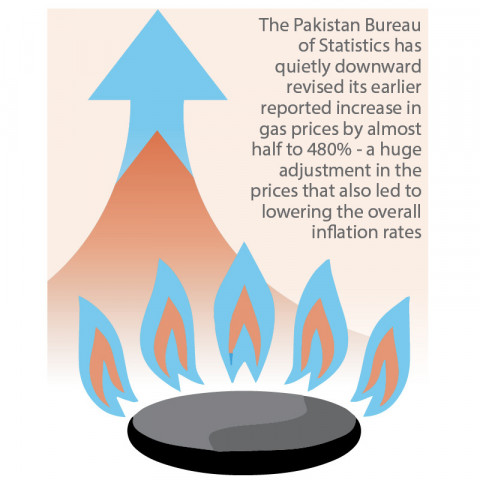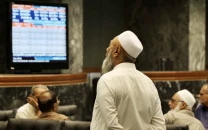PBS revises gas price surge to 480%
Adjusts Nov rates from 1100%, raises questions on impact on inflation metrics

The Pakistan Bureau of Statistics has quietly downward revised its earlier reported increase in gas prices by over half to 480% – a significant adjustment that also contributed to a lower overall inflation rate in February.
The PBS made the revision in the rate of increase in gas prices without making an adjustment in the methodology. The revision was the result of a correction of an error in calculations, said the sources. PBS had earlier reported that the government increased the gas prices up to 1100% in November 2023, but the Ministry of Energy said that the increase was not more than 150%.
A 57% cut in the reported figure of the increase in prices – from 1108% for the lowest strata to 480% – was still below the claims made by the Ministry of Energy.
Just before leaving office, former energy minister Mohammad Ali wrote to Planning Minister Sami Saeed, requesting an adjustment to the inflation figures in light of observations made by the Petroleum Division during recent meetings.
The PBS reported that prices went up by 1109% for Pakistan’s lowest income group, earning up to Rs17,732 per month.
Sources in the Ministry of Planning said that there was an error in calculations, which led to the reporting of a 1109% increase in prices for the lowest quintile. They said that after making this correction, the effective increase in gas prices for the lowest income group was 480%.
But PBS never made a public announcement about the downward revision and quietly released the Sensitive Price Index (SPI) report for the third week of February based on the new numbers. The Chief Statistician Dr Naeemul Zafar claimed that the PBS did not make any adjustment in gas prices.
The PBS report showed that during the week ended on February 22nd, the increase in gas prices for the lowest quintile was 480%. It made a significant adjustment, resulting in a sharp dip in the overall SPI index from 34.2% to 30.6%.
This downward revision in gas prices also contributed to a reduction in the Consumer Price Index (CPI) in February, which slowed down to almost a year and a half’s lowest level at 23.1%.
The inflated inflation figures have serious implications for Pakistan’s debt sustainability, as the central bank sets interest rates based on the overall inflation rate. A 1% higher interest rate costs the country’s economy between Rs260 billion to Rs280 billion per annum on the existing debt stock.
In January, the Special Investment Facilitation Council (SIFC) intervened to resolve the dispute over the actual increase in gas prices. The dispute landed in the SIFC after PBS and the Ministry of Energy provided varying figures two months ago.
The interim government had imposed fixed monthly charges in the range of Rs465 to Rs2,000 per consumer and argued that these charges should not be part of the price increase calculation. However, PBS included the fixed charges in its calculation.
Secondly, the Ministry of Energy claims that the majority of consumers were exempt from the price hike.
The sources said that a meeting of the technical committee held last week decided that no revision in the methodology would be made at this stage.
The outgoing energy minister wrote to the planning minister four days ago and sought to fix the anomalies.
The energy minister expressed the need for PBS to revisit its calculations of the cumulative impact of gas price increases in November 2023, which was around 150% and not just one quintile erroneously computed as 1,100%, and adjust the inflation figures accordingly.
Ali was of the view that the claimed gas price increase of 1100% had implications on SPI and CPI. He pointed out that major anomalies in PBS’s calculations have been identified.
The Petroleum Division argued that the PBS compared the lowest slab of tariff structure of November 2022, when the concept of protected consumers did not exist, with the lowest slabs of non-protected consumers. This led to a comparison of November 2022’s lowest slab tariff of Rs121/mmbtu with the current lowest tariff of non-protected consumers of Rs500/mmbtu with an application of fixed charge of Rs1,000 per month.
The Petroleum Division claimed that PBS’s calculations have errors related to a comparison between different categories of consumers and an increase in tariff instead of the increase in the bill amount.
It claimed that an increase in variable gas tariff and the addition of a fixed monthly charge do not necessarily mean that the increase in tariff will be the same as the increase in the monthly bill amount.
The Petroleum Division further stated that the consumption in hectometre is not converted into energy units which are mmbtu. All these factors, which have not been taken into consideration, have resulted in incorrect calculations of the bill amount.
It further added that currently 57% of the gas consumers in Pakistan fall into the protected consumers’ category that is altogether ignored in PBS’s calculation.
The tariff increase of these protected consumers is minimal, ranging between Rs30-100 per mmbtu, and the application of fixed charge on these consumers is also half or even lesser than the non-protected consumers, according to the Petroleum Division.
It said that ignoring protected consumers has further aggravated the impact of incorrect calculation. The PBS has considered 9.4 million consumers, plotted in the respective slabs. This is based on the number of meters as per 2018 data and their average consumption per month for the year. As gas consumption observes seasonal variations throughout the year, every meter falls under different consumption slabs throughout the year.
It said that averaging their annual consumption leads to a lower number of consumers in the protected category whereas in reality a larger number of consumers were in the protected category during the month of November.
The energy minister wrote that these discrepancies require a thorough re-look into the calculations which are then reflected in tariff increases for reporting in SPI and CPI.
Published in The Express Tribune, March 7th, 2024.
Like Business on Facebook, follow @TribuneBiz on Twitter to stay informed and join in the conversation.


















COMMENTS
Comments are moderated and generally will be posted if they are on-topic and not abusive.
For more information, please see our Comments FAQ